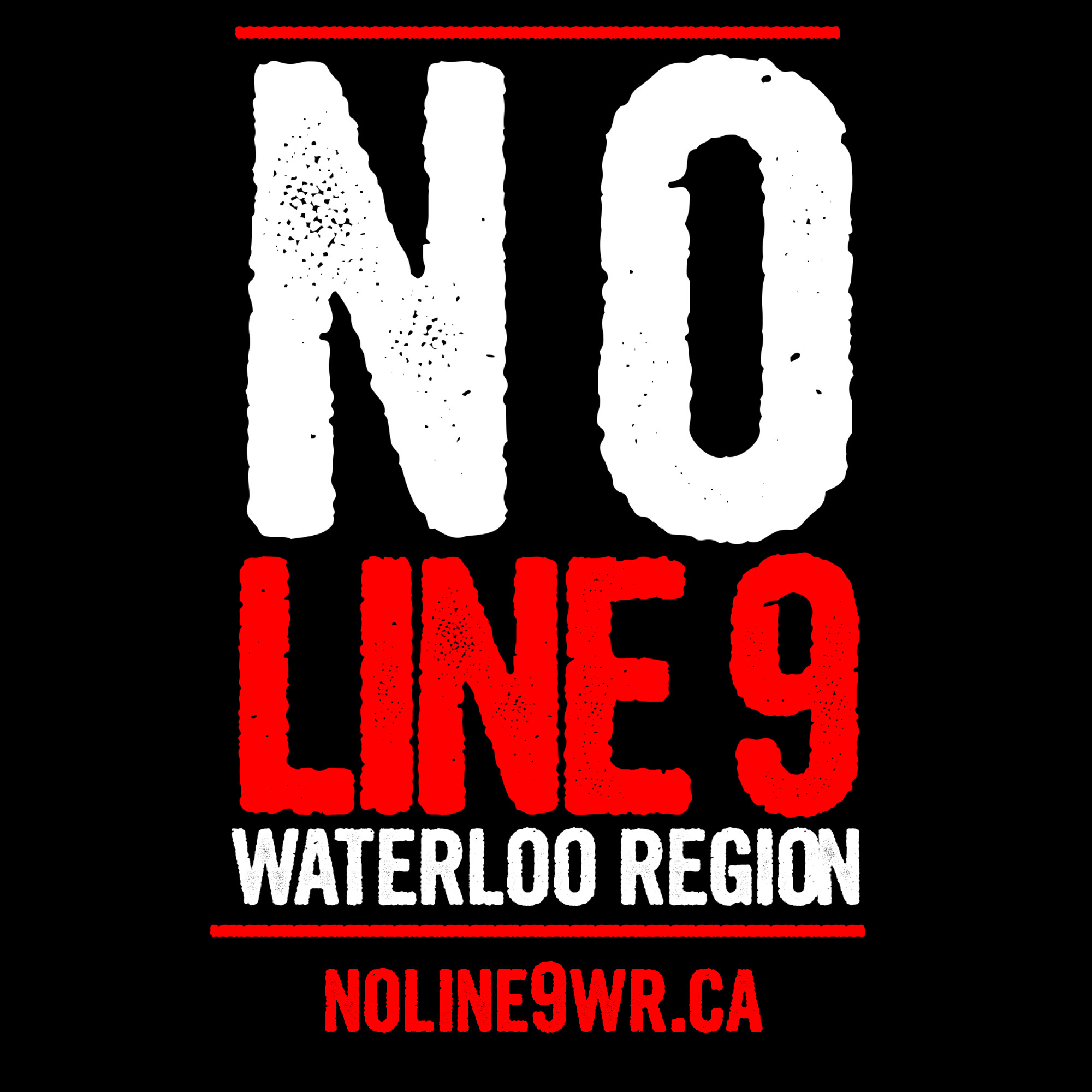Submitted by noline9 on
Line 9 is a 39-year-old pipeline that crosses the Waterloo Region. Enbridge Inc. has applied to send tar sands through the pipeline, which would threaten life around and downstream from the pipeline. To bring tar sands from Alberta, Enbridge also will be reversing the flow through the pipeline (so that it flows from west to east, rather than east to west).
This pipeline has been transporting light crude oil between Montreal, Quebec, and Sarnia, Ontario. The pipeline runs through hundreds of communities, the territories of many Indigenous nations, and dozens of watersheds, including the Grand River.
If Enbridge has their way, Line 9 would carry a form of tar sands known as diluted bitumen. The pipeline was not built to transport this corrosive and toxic compound, which poses a particularly dire threat to communities and ecosystems. In 2010, a break in the nearly identical Enbridge pipeline in Kalamazoo, MI, caused the largest inland oil spill in American history, which the company is still struggling to clean up three years later. When Enbridge proposed essentially the same project as the Line 9 reversal in 2008, under the name Trailbreaker, it was successfully opposed based on safety concerns. Just because Enbridge is currently seeking approval for the project piece by piece—the reversal of the first half last year, and the second half plus the transport of bitumen this year—there is no reason for us to accept it now. The threats remain just as serious.
While the project has been rubber stamped by the industry aligned National Energy Board, the grassroots and community level resistance to this pipeline remains strong. See the timeline of events since the NEB for more
See details on map for Line 9 pipeline route:
View Haldimand Tract in a larger map
Enbridge:
The biggest oil and gas pipeline company in Canada, with an extensive network of pipelines serving different products to markets.
Their pipelines have spilled over 800 times between 1999 and 2010, according to Enbridge's own data, causing approximately 6.8 million gallons of hydrocarbons to be released into the environment. In addition to Line 9, Enbridge has other pipelines and proposed projects that would also facilitate tar sands expansion. For instance, there is Enbridge’s Alberta Clipper pipeline from Alberta to Wisconsin (which can transport 450,000 barrels per day), and their proposed Northern Gateway pipeline from Alberta to the Pacific coast (which would see an additional 525,000 barrels per day being pumped out of the tar sands). The Line 9 reversal would add another 300,000 barrels a day to these figures, making it possible to further expand tar sands production.
Tar Sands:
The largest and most destructive industrial project on earth.
Threats To the Waterloo Region:
1) The transport of bitumen through this pipeline poses a terrible risk to the Grand River and the surrounding watershed. We all rely on the watershed to sustain life within this region, but given Enbridge's track record of pipeline spills, leaks, and failures, Line 9 will put the shared environment and collective health of our region in jeopardy. If we let this reversal happen, we are endangering drinking water for this Region, as well as that of every community downstream on the Grand River.
2) Reversing Line 9 will provide no benefits to the Waterloo Region or local residents. It will not create jobs or provide new sources of energy for the municipality; local industry is not supported by the pipeline, and the bitumen passing through the pipeline will be shipped to markets in the United States and overseas. Yet, were a spill to occur, it would threaten the land on which our food is grown, and the rivers and aquifers from which our drinking water is drawn. This reversal poses a great risk to farms, small businesses, public institutions, rural and urban communities alike, and to our economy overall.
3) The reversal of the pipeline violates current treaties with Indigenous communities, both within the Haldimand Tract and elsewhere along the route. There has been no free, prior, and informed consent from these communities with regard to this pipeline project, which already cuts through their lands and territories. As residents on the Haldimand Tract (Six Nations’ Grand River Territory) it is crucial that we respect and act on this responsibility to consult.
4) Bitumen is more difficult and expensive to clean up than conventional crude. Recent spills like the one in Kalamazoo, MI, are evidence that Enbridge’s clean-up process and safety procedures have been woefully inadequate in dealing with the inevitable release of toxic tar sands bitumen. Given Enbridge’s track record of 800 significant pipeline spills in the past 15 years alone, we can expect spill incidents along Line 9. It is not a question of if but when this will happen here. Enbridge expects local responders to take responsibility in such emergencies. Thus, the cost of clean-up for a pipeline failure would result in increased financial burdens on local government, and would tax the capacity of our emergency responders.
5) The reversal will further entrench our region in the carbon economy, which contributes to climate change. This will lead to more frequent and devastating natural disasters. Pipeline projects like Line 9, the Keystone XL, and Northern Gateway, support the expansion of the Alberta tar sands industry. We envision a future where our lives and economies are not dependent on fossil fuels and do not contribute to the greenhouse gases and additional pollutants they produce. We recognize that supporting further extraction from the tar sands and other fossil fuel energy sources will continue to prevent the development of real sustainable alternatives.
Resistance To Line 9 and Tar Sands Pipelines:
http://swampline9.tumblr.com
http://noline9.ca
http://line9communities.com/



